Where: Camaiore - town of Capezzano Pianore (Acquarella)
When: VI century BC - VII century BC
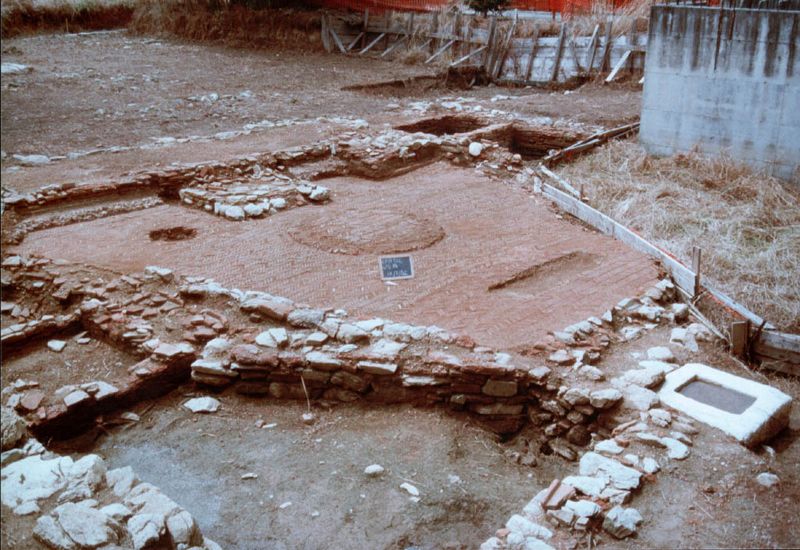 Acquarella rural settlement, located at the Junction point between Versilia's lowland and Camaiore's Valley, has been highlighted between 1994 and 2002. Its position along coastal routes and at the junction with direct routes to the Serchio valley, as well as the proximity to the northernmost shore of Lake Massaciuccoli (which according to recent geomorphological investigations went as far as the plain of Camaiore), may have also favored a role of this settlement in the traffic network along the land and water routes.
Acquarella rural settlement, located at the Junction point between Versilia's lowland and Camaiore's Valley, has been highlighted between 1994 and 2002. Its position along coastal routes and at the junction with direct routes to the Serchio valley, as well as the proximity to the northernmost shore of Lake Massaciuccoli (which according to recent geomorphological investigations went as far as the plain of Camaiore), may have also favored a role of this settlement in the traffic network along the land and water routes.
The farm was built in a protected and well exposed area at the foot of the hills cultivated with olive groves: in Roman times, olive oil was essential for feeding, but it was also used for the realization of cosmetic balms and medicines.
The settlement goes through different phases of occupation, from the Etruscan age (VI - V centuries BC) to the Roman age and up to the High Middle Ages (VI - VII centuries AD).
The presence of the Etruscans on the site is already sporadically proven in the VI century BC , a period to which dates back a fragment of bucchero cup. Bucchero is a fine ceramic with a characteristic black color obtained with cooking and it was typical of the Etruscan world. However, the ceramics found offer are more referable to the V century BC, when the tradition of bucchero is replaced throughout the Pisa area by new productions of tableware. Also deep bowls with a slightly recessed profile, made with a technique that gives the mixture a gray-blue color, are widespread in this period . A cup of black-painted pottery of Athenian production( kylix ) dates back to the V century BC, too: this type of fine pottery was widespread thanks to the flourishing network of ports and port settlements that served the Tyrrhenian merchant routes and redistributed goods in the territory . The settlement was abandoned around the first half of the IV century BC, as other Etruscan sites in the area, which were abandoned or reduced between the V and IV centuries BC.
The farm activity has its peak during the Roman Age, between the II-I centuries BC and the IV-V centuries AD, when the Apuan-Versilian plain is subjected to the project of rational exploitation of territory between Pisa and Luni (centuriation) after the Roman conquest of the II century BC. The rooms used for the production cycle of the oil date back to that time: a large tank where the olives are deposited before pressing, a smaller one for washing, with a duct for discharging dirty water and residues to the exterior and an environment equipped to house the olive pressing wine (torcularium) on a opus spicatum pavement (bricks arranged in the shape of a herringbone pattern), replaced during Imperial Age with a “coccio pesto” pavement, with the pressing area in the center. It is a catonian type press, with lever and winch, of considerable size and with limestone bases for the stipites and the arbores . After pressing the olives, the olive oil flows into a system of settling tanks lined with cocciopesto. Adjacent to the press are the area of the cavedio , a sort of courtyard that houses the mill for pressing the olives, used for the maneuvers necessary to activate the lever of the press, as well as a storage space for the oil in which at least five large terracotta dolia are still housed for storage. The dolia were huge jars that could hold up to 1,000 liters of olive oil.
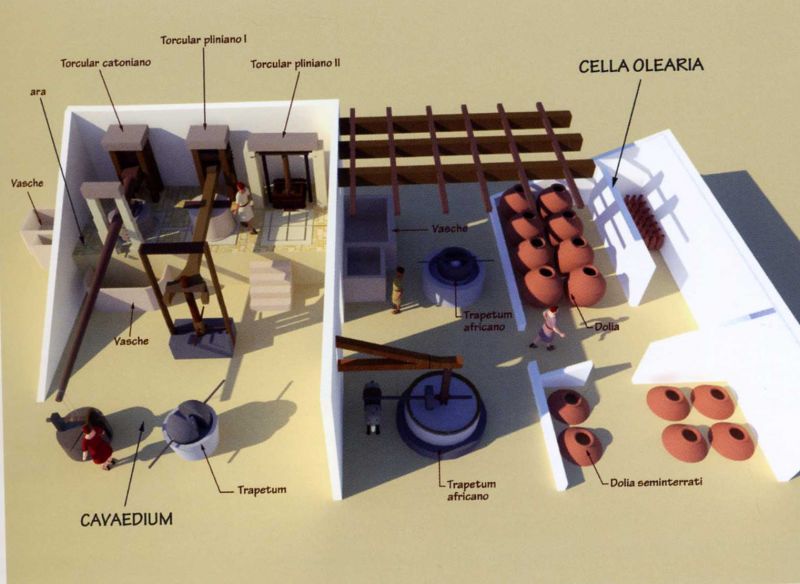
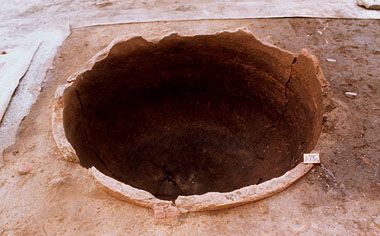
At the beginning of Imperial age the torcolarium is transformed and probably in this phase (from the middle of the I century AD) a new type of lever-type press and screw was introduced to replace the Catonian type. A long and narrow tank behind the press, with a hole for the passage of olive oil, can be interpreted as a collection area for the crushed olives pasta waiting to be pressed or as a grinding wheel for the pressing where the olives, placed in a tank elongated, they were squeezed by workers who wore heavy wooden clogs.
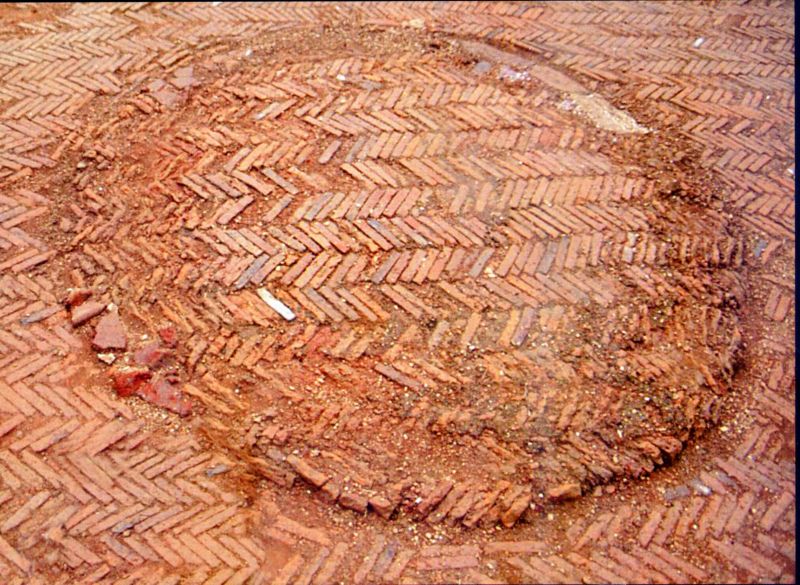
To Roman Age belong a series of artifacts related to everyday life, too, especially tableware of various types (pans, bowls, cups, plates, vases, jugs, etc.), but also bronze and iron objects (a fibula - a brooch - and a tintinnabulum - a little bell). In the first phase of development of the settlement there is black-painted table pottery, with a repertoire of forms similar to that of the final phase of productions in the Etruscan area. Starting from the second half of the I century BC a new type of pottery is introduced, characterized by a shiny red crystalline coating (the Italic sealed land ), an innovative technique born in Arezzo and soon implanted in Pisa. Cups and plates acquire refined decorative motifs made with a matrix, with numerous workshops that stamp their mark on the vases. The site of the Acquarella is certified by the L.Tettius factory stamp, a potter active in Pisa at the end of the I century BC. There were also kitchen ceramics imported from the Campania region of Lazio, used for the transport of wine and garum , the famous salted fish conserve.
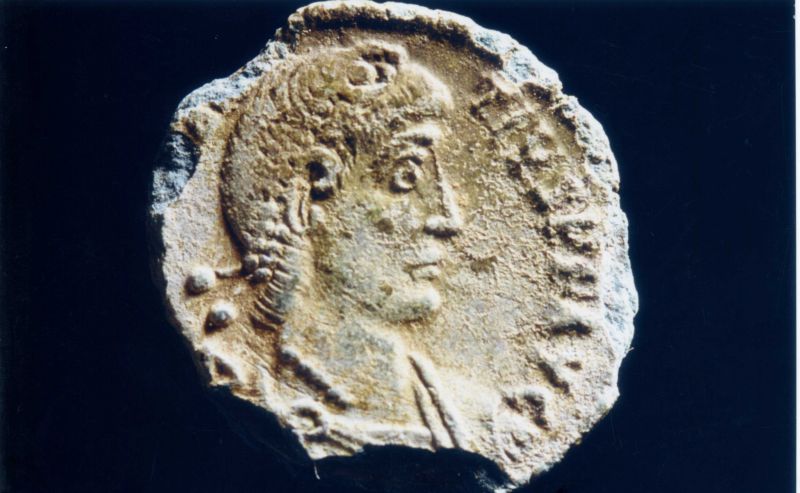
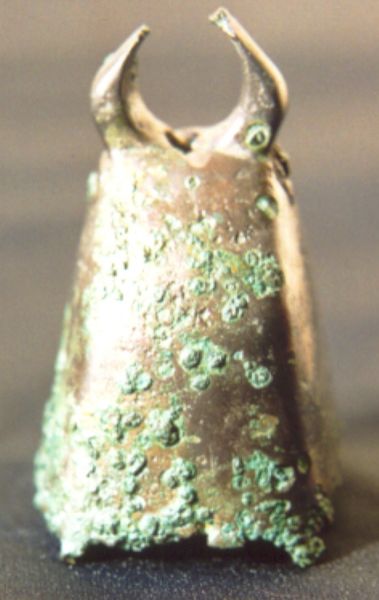
739/5000From III - IV centuries AD the number of ceramics imported from Africa starts to increase: this datum is common to all the settlements of the region, both in the coastal area and in the internal area. This is a period of prosperity and intense commercial exchanges with other regions: African-produced crockery is distributed throughout the Mediterranean and at Acquarella come different types of table bowls of Tunisian production. Imported ceramic starts to disappear during the V century AD, when they are supplanted by tableware and kitchenware of local production. The peculiarity of these ceramics (made between Luni, Pisa, Volterra and Lucca) is that they try to imitate those of African origin.
During the VI century AD the farm of the Acquarella is abandoned : later, the accumulation of waste in the tanks indicates the beginning of a new settlement, formed by a group of huts with plans of use in beaten topsoil covering the ancient floors. Holes are created for lighting fires and for burying waste (even the dolia are used for this function). Finally, it is worth mentioning a dry-stone wall structure that seems to protect the northern side of the settlement (perhaps in defense of the water).
The finds are exhibited at the Civic Archaeological Museum of Camaiore.
The Civic Archaeological Museum of Camaiore plans to place information signs during the future realization of the archaeological area project.
The area is currently not accessible.

